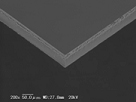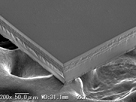Processing Sapphire with Lasers
Solutions
The range of applications for high-intensity LEDs has begun to expand. In addition to cell phones, they
are used in liquid-crystal TV backlights, car headlights, and lighting. Mid- to long-term growth in the
market is expected.
When processing the sapphire used in high-intensity LEDs, separation using a diamond scriber and breaking
has been the standard. However, as the market has grown, there has been strong demand for improved
throughput and yield ratios. Laser processing has rapidly become more prevalent, and it is becoming the
standard for processing sapphire for use in high-intensity LEDs.
This page describes sapphire processing using DISCO's laser saw.
Problems with Diamond Scribers
The following problems have been pointed out with regard to the conventional process of separation using
diamond scribers and breaking:
- Variable processing quality
The yield ratio is not stable because the process is dependent on the operator's skill. - Operating costs
It is necessary for the operator to always stay close to the equipment, which results in higher labor costs. - Number of machines
Since throughput cannot be increased, a lot of machines are required.
Advantages of Processing Sapphire with Lasers
In terms of processing methods with lasers, there are ablation processing and a method that uses stealth
dicing.
In comparison to the conventional processing method, using a laser saw to process sapphire maintains the
same light intensity while having various advantages, such as improved throughput and yield ratios and
reduced operating costs.

* The water-soluble protection film HogoMax coating function is optional.

- Improved Throughput
High feed speed, several times that of a diamond scriber, results in significantly improved throughput. - Improved Yield Ratio
Simply by entering the processing parameters, it is possible to maintain consistent processing quality without relying on the operator's skill. - Reduction in Operator's Duties
With a fully automated machine, full automation is possible just by entering the device data and setting a cassette onto the machine. It is possible to cut down on the time spent exchanging wafers and significantly reduce the operator labor and man-hours required with a diamond scriber.
Advantages of Processing Sapphire by Stealth Dicing
For high value-added devices requiring high light intensity, processing with stealth dicing, with which almost no reduction in intensity occurs, is ideal. Since separation is performed using internal processing, it is possible to narrow the street and to expect an increase in the number of possible die. And even if the substrate is thick, die separation which reduces the decrease in intensity is possible.
The respective advantages and disadvantages of processing sapphire using a diamond scriber or laser saw are as shown in the table below.

Examples of Sapphire Processing
-
Photo 1. Processing with Ablation

200x
Breaking after laser scribing -
Photo 2. Processing with Stealth Dicing

200x
Breaking after stealth dicing
Process handling equipment
-

DFL7160
Machine for Ablation Processing
For Φ300 mm wafers
Fully automatic laser saw -

DFL7341
Machine for Stealth Dicing
For Φ200 mm wafers
Fully automatic laser saw -

DFL7362
Machine for Stealth Dicing
For Φ300 mm wafers
Fully automatic laser saw
Contact
Please feel free to contact us with any questions or inquiries.
-

Applications Support
A free-of-charge test cut is performed at an application lab to confirm whether achieving the customer's needs is possible.
Details -

Dicing and Grinding Service
It is effective in sample and prototype manufacturing during development or low-volume production. Designated engineers will provide support based on the desired leadtime and at reasonable cost.
Details
